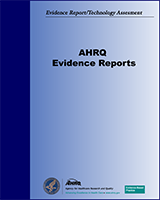This publication is provided for historical reference only and the information may be out of date.
Manifestations and Management of Chronic Insomnia in Adults
Evidence Reports/Technology Assessments, No. 125
Authors
Investigators: Nina Buscemi, PhD, Ben Vandermeer, MSc, Carol Friesen, MA, MLIS, Liza Bialy, BSc, Michelle Tubman, BSc, Maria Ospina, MSc, Terry P Klassen, MD, MSc, FRCPC, and Manisha Witmans, MD, FRCPC, Dip ABSM.ReadStructured Abstract
Context:
Approximately 40 to 70 million Americans are affected by either intermittent or chronic sleep problems, representing approximately 20 percent of the population.
Objectives:
To conduct a systematic review of (1) the prevalence, natural history, incidence, risk factors and consequences of chronic insomnia in adults and (2) the efficacy and safety of treatments used in the management of chronic insomnia in adults.
Data Sources:
A systematic search of twenty-one electronic databases was conducted. We searched MEDLINE®, EMBASE, CINAHL®, Ovid MEDLINE In-Process & Other Non-Indexed Citations, Ovid OLDMEDLINE®, PsycINFO®, EBM Reviews-Cochrane Central Register of Controlled Trials, International Pharmaceutical Abstracts, AMED (Allied and Complementary Medicine), HealthSTAR/Ovid Healthstar, EBM Reviews-Cochrane Database of Systematic Reviews (CDSR), ACP Journal Club (ACPJC), Database of Abstracts of Reviews of Effects (DARE), Science Citation Index Expanded™, Biological Abstracts, Cochrane Complementary Medicine Field Registry, CAB Abstracts, SIGLE, OCLC Proceedings First, Dissertation Abstracts, Alt HealthWatch, NLM Gateway and PubMed®.
Study Selection:
Cohort, case-control and cross-sectional studies were eligible for questions on manifestations of chronic insomnia. Randomized controlled trials were eligible for the question on management of chronic insomnia.
Quality Assessment:
One of three instruments was used to assess the quality of studies relevant to the manifestations of chronic insomnia. The Jadad Scale was used to assess the quality of studies relevant to the management of chronic insomnia. The concealment of treatment allocation was also assessed in the latter studies.
Data Analysis:
Data were analyzed both qualitatively and quantitatively. The Random Effects Model was used for quantitative analyses.
Main Results:
The interquartile range of prevalence of chronic insomnia varied from 8.5–24.3 percent across high quality studies of general populations, to 19.8–53.7 percent across moderate quality studies of outpatient populations, to 27.8–43.0 percent across moderate quality studies of clinical populations. Sleep onset latency (SOL) was significantly decreased by benzodiazepines (Mean Difference (MD): -16.5, 95% Confidence Interval (CI): [-20.5, -12.5]), non-benzodiazepines (MD: -18.1, 95% CI: [-22.5, -13.7]), antidepressants (MD: -7.4, 95% CI: [-10.5, -4.4]) and melatonin (MD: -8.3, 95% CI: [-14.5, -2.0]). All of the preceding interventions, except melatonin, had a significantly higher risk of harm compared to placebo: benzodiazepines (Risk Difference [RD]: 0.15, 95% CI: [0.10, 0.20]), non-benzodiazepines (RD 0.05, 95% CI: [0.01, 0.09]), antidepressants (RD: 0.09, 95% CI: [0.01, 0.18]) and melatonin (RD: 0.09, 95% CI: [-0.11, 0.29]). Wakefulness after sleep onset (WASO) was not significantly reduced by melatonin (MD: -9.7, 95% CI: [-33.6, 14.3]). SOL was significantly decreased by relaxation therapy with short-term treatment (less than 4 weeks) (MD: -22.0, 95% CI: [-41.0, -2.9]); however, WASO was not significantly reduced by relaxation therapy (MD: -1.6, 95% CI: [-14.1, 10.8]). WASO was significantly decreased by cognitive/behavioral therapy (MD: -18.2, 95% CI: [-30.4, -6.0]); however, SOL was not significantly reduced by cognitive/behavioral therapy (MD: -4.6, 95% CI: -9.8, 0.6).
Main Conclusions:
There is evidence that chronic insomnia is associated with older age, female gender, present or past psychiatric illness and psychological problems, medical conditions and poor general health, increased healthcare utilization, lower quality of life and social relationships, socioeconomic status (marital separation, unemployment, poorer working conditions and lower social status), and decrements in memory, mood and cognitive function.
There is evidence that benzodiazepines and non-benzodiazepines are effective in the management of chronic insomnia. There is some evidence that antidepressants are effective in the management of chronic insomnia: more research is required in this area. There is evidence that benzodiazepines, non-benzodiazepines and antidepressants pose a risk of harm.
There is some evidence that melatonin is effective in the management of chronic insomnia in subsets of the chronic insomnia population, and there is no evidence that melatonin poses a risk of harm. However, more research is required in this area, given that the results are based on a small number of studies.
There is evidence that relaxation therapy and cognitive/behavioral therapy are effective in the management of chronic insomnia in subsets of the chronic insomnia population.
There is evidence that benzodiazepines have a greater risk of harm than non-benzodiazepines.
Prepared for: Agency for Healthcare Research and Quality, U.S. Department of Health and Human Services.1 Contract No. C400000021. Prepared by: University of Alberta Evidence-based Practice Center, Edmonton, Alberta, Canada.
Suggested citation:
Buscemi N, Vandermeer B, Friesen C, Bialy L, Tubman M, Ospina M, Klassen TP, Witmans M. Manifestations and Management of Chronic Insomnia in Adults. Evidence Report/Technology Assessment No. 125. (Prepared by the University of Alberta Evidence-based Practice Center, under Contract No. C400000021.) AHRQ Publication No. 05-E021-2. Rockville, MD: Agency for Healthcare Research and Quality. June 2005.
This report may be used, in whole or in part, as the basis for development of clinical practice guidelines and other quality enhancement tools, or a basis for reimbursement and coverage policies. AHRQ or U.S. Department of Health and Human Services endorsement of such derivative products may not be stated or implied.
AHRQ is the lead Federal agency charged with supporting research designed to improve the quality of health care, reduce its cost, address patient safety and medical errors, and broaden access to essential services. AHRQ sponsors and conducts research that provides evidence-based information on health care outcomes; quality; and cost, use, and access. The information helps health care decisionmakers—patients and clinicians, health system leaders, and policymakers—make more informed decisions and improve the quality of health care services.
The authors of this report are responsible for its content. Statements in the report should not be construed as endorsement by the Agency for Healthcare Research and Quality or the U.S. Department of Health and Human Services of a particular drug, device, test, treatment, or other clinical service.
- 1
540 Gaither Road, Rockville, MD 20850. www
.ahrq.gov
